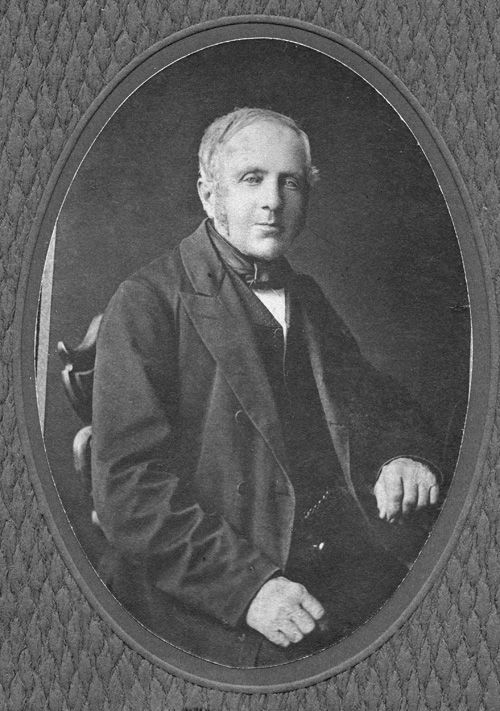
 Fall 2008
vol. 63 no. 2
Back to Table of Contents
Fall 2008
vol. 63 no. 2
Back to Table of Contents
Melvin D. Epp is a Wheaton College graduate with a doctorate in genetics from Cornell University. Following a corporate career in biological research, he retired to his ancestral farm near Whitewater, Kansas to write. He is currently compiling an anthology of his mother's prairie poetry, which includes the history of the immigration of his West Prussian ancestors in 1876.
Leaving behind his beloved, manicured garden was difficult, but guided by faith and conscience Bernhard Harder, Sr. (1811-1900) sold the beautiful prosperous farm and garden that he had nurtured for 44 years and joined the first group of emigrants leaving West Prussia for America. He was 65 years old, but to create the opportunities he wanted for his three sons who were approaching military draft age, Johannes (22), Gustav (20), and Bernhard (11), the relocation was timely.
"…Oh, many of us don't realize what it meant for them, I fear,
To leave their parental inheritance and to become a pioneer.
It meant the breaking of friendship bonds, even families had to
sever,
They disposed of many a treasured thing and said "good-bye"
forever…"(1)
Bernhard Harder, Sr. was my great-grandfather and from the inscription on his monument on the Harder Cemetery at the end of his Kansas farm driveway, I learn that "Hier ruhet in Frieden [Jesus meine zuversicht] unser innig geliebte Gatte, Vater und Grossvater Bernhard Harder Geb den 12 Maerz 1811 in Marienau, West Prussia, eingewandert in Junie 1876, Gest den August 1900, Alt gewerden 89 Jahre 5 monate, Ruhe sanft. Here rests in peace [Jesus, my absolute security] our profoundly beloved husband, father, and grandfather born on March 12, 1811 in Marienau, West Prussia, immigrated in June 1876, died in August 1900, attained age of 89 years, 5 months. Rest in comfort."

In writing his father's obituary, son Gustav wrote, "Our dearly beloved father had a great love for people, particularly fond of children and a special friend to them. He was also a great naturalist and gardener. Three times his beautiful plants were destroyed because of the floods [1839, 1845, and 1855] and each time he had, with the help of his heavenly Father, been able to restore his beautiful garden again. Little wonder that his beautiful property in his old home became very dear to his heart. And yet, there came a time when all this must be left behind to follow the name and will of the Lord Jesus."(3)
My great-grandfather was born to Hans (1764-1815) and Helene (Reimer) Harder (1790-1812) in 1811. In 1812 his sister Marie (1812-1844) was born and their mother also died later that year. These two children were raised by their grandmother. Hans passed away three years later, so Bernhard and Marie were orphaned as toddlers. At the age of 17, Bernhard went to stay with his Uncle Abraham Harder in Heubuden. He employed himself on the farm of the widow Anna (Peters) Regier, who had four partially grown children. Oral history reports that Anna Regier was impressed with Bernhard; he had endeared himself to her children and was successfully managing her farms, so she suggested that they get married. On October 9, 1832, at the age of 21, he married Anna who was 28 years older. They were compatibly married for 20 years and a close, love-filled friendship always existed between him and her children and grandchildren. It was Anna's farm that Bernhard nurtured for 44 years and where he created his garden before he emigrated to America with his three sons of subsequent marriages. This was the period in the history of the Vistula Delta beginning in 1789 when the procurement of land by Mennonites was restricted; however, widows could control the perpetuation of their farms by marrying young men who inherited the widows' properties upon their deaths.(4)
On November 4, 1861, Great-grandfather's second wife passed away. "In this time when our beloved father experienced for the second time the loneliness of widowhood, he took us [Johannes, 7, and Gustav, 5] often with him into the prayer room [a room planned into the architecture of the homes at that time for the express purpose of prayer] and taught us in this way to take our burdens to the Lord."(5)
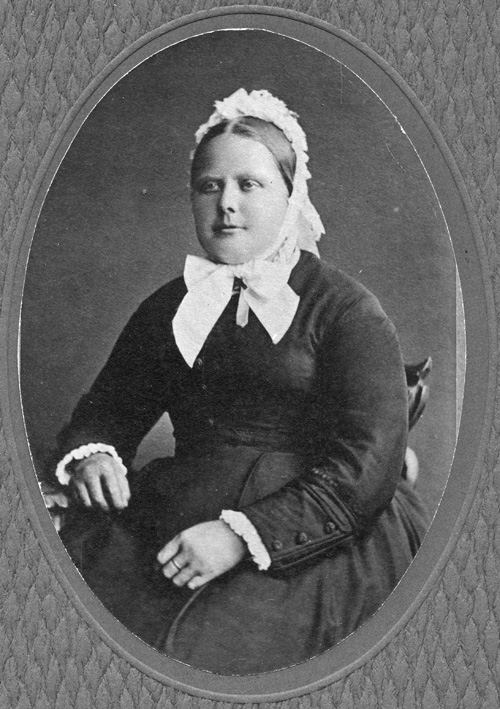
On July 16, 1863 he married Justine Bergmann (1834-1916). My grandfather, Bernhard Harder, Jr. (1864-1904) was their only surviving child. When the family immigrated, Justine with the other womenfolk remained in Halstead with relatives until the Speicher (granary), the first building on their newly acquired prairie land, was completed. She then moved her family into this granary for the first winter until her new spacious house was completed in July, 1877.(6)
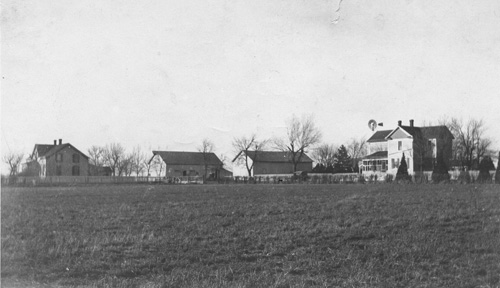
The menfolk made their first trip to their newly acquired railroad land in September, 1876. They left Halstead on a Monday morning by way of Newton to purchase horses, harnesses, wagons, and mowers and arrived at their "new home" late in the afternoon.
"These were not as we see it now, with good farms everywhere,
With roads and trees and fences and highways here and there.
The warm breeze was swaying the prairie thick and high
And overhead was stretching the azure summer sky…"(7)
Upon the completion of this first building on the prairie and when the family had set up housekeeping, my great-grandfather invited his neighboring West Prussian pioneers to Sunday worship in the Speicher. Bernhard had been the Vorsänger (chorister) at the Heubuden Church, their home church in West Prussia, from 1836-1876. Singing was an integral part of worship and so with a sense of sharing his worship leadership tradition, he invited the Rev. Wilhelm Ewert to conduct the first service. Rev. Ewert, formerly an elder of a church in West Prussia, who represented the interest of the West Prussian Mennonites on the exploration trip to America in 1873, had come to the Hillsboro area a year earlier and founded the Brudertal congregation. The group of worshippers that met in the Speicher formed the nucleus of what has become the Emmaus Mennonite Church.(8)
"Our farm had a granary shed with many fascinations. Instead of climbing a ladder, we stepped up on a broad stairway leading to the second floor… Through inquiry, I learned that this was the original gathering place for the Harder family and their neighbors on Sundays."(9)
Justine was gregarious and loved to entertain guests in her home. Bernhard, Jr.'s daughter Marie (1903-1998), my mother, recalls her impressions:
"…Who can not still clearly with mind's eye remember
How it once was in grandmother's house‘
Who does not remember all the space,
The sunny rooms, the dark halls
Where grandmother eagerly celebrated festivities
And often entertained many guests.
They were very happy with the hospitality,
Which all remain in our memories.
The New Year's celebrations we still call to mind,
How good the evening meal always tasted.
Which all the descendants and relatives
Constantly acknowledged with pleasure,
Grandmother really understood how to fry chicken
Like no one else here in this country,
So whatever one's personal tastes are,
It came from the abundance of ingredients.
And then when all were satiated
The evening prayers would soon begin.
To begin, a song of thanksgiving was sung
And when the last phrase faded
Uncle Gustav Harder often took the Bible
And gave a nice festive speech.
How we all loved to hear him
And some remained unforgettable.
From the little ones, poems were recited
Larger children came to say their best wishes:
That God's blessings for the new year
Was again their wish for grandmother.
Then everyone was happy though
That she pressed into each hand a taler..."(10)
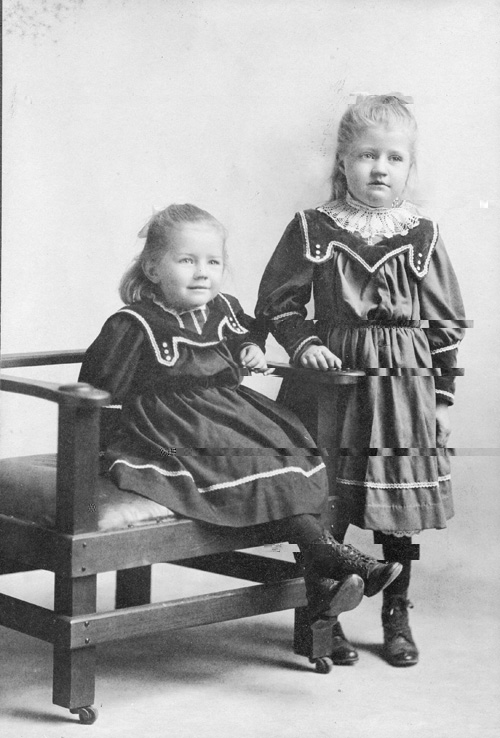
But in summertime, Justine entertained guests in the garden that Bernhard had created south of the house. This garden was a replica of the garden he nurtured on his farm in Gurken, West Prussia. Justine also was a lover of animals and had two dogs named Fido and Hector; these dogs were bathed before social events and a ribbon tied around their necks. When she fed her cats she was concerned that each get their fair share, and if one became greedy, she refereed the situation with her wooden spoon.(11)
In summertime, one special occasion was the celebration of Justine's birthday on July 9. Marie enjoyed this activity as a child and fondly remembers running around in the garden. When Marie was in her early 30s, she recorded her memories of the celebrations and of the garden in a tribute to her grandmother as the family celebrated Justine's 100th birth date.
"During the hot summertime
She gladdened us with another celebration—
Her birthday — who does not remember that
And everyone appeared happy
Also, everything was so nicely planned
Surely that was recognized by everyone.
Then with ice cream, at that time much more rare than today
The adults and children enjoyed it very much.
One truly preferred to sit outside then
And with a perfectly lovely evening
With pleasure one would walk through the beautiful garden
Which had so many unique features.
How surely far and wide one now
Nowhere does one find a garden like this anymore
How well we still remember that garden
How nicely it was scented with flowers
The same was true at the entrance with a wide path
Two cedars extended their broad branches
Further on the path we proceed suddenly to
A view of the garden
On the left were the flowers, on the right the vegetables
A little further to the back
There stood fruit trees, behind that the grapes
In two areas in nice bounded rows
Also there were two arbours and a garden house
Happily we children went in and out of them
And where once was an empty space
Now stood a nice apple tree
Many different flowers were planted there
Near where the large oleander stood
Verbena, stocks, and thymes
Which were constantly beautiful to look at
In the house there were many cyclamen
Which were however always the loveliest of all."(12)
When Marie was in her 70s, a niece asked her to diagram her recollection of great-grandfather's garden since no photographs of the garden have been found.
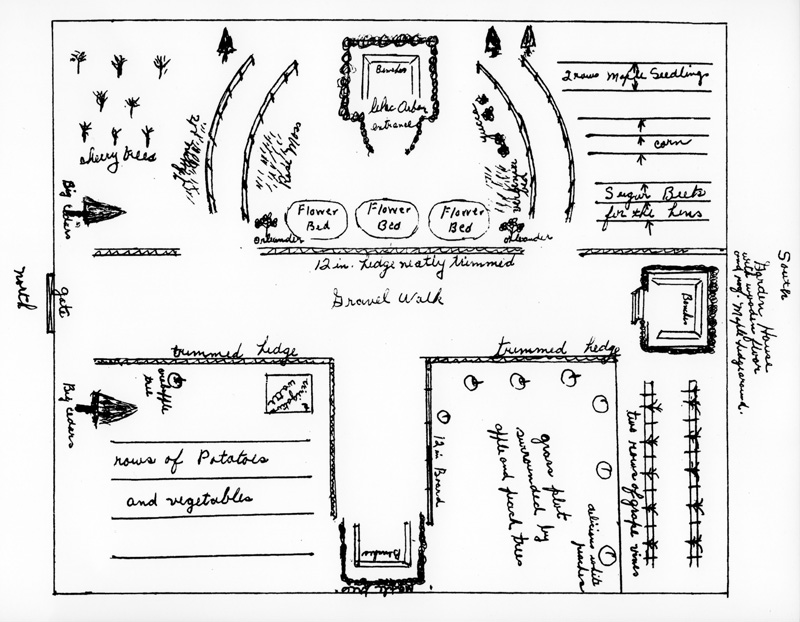
Walking south from the house, one came to the garden gate flanked by large cedar trees. Proceeding between the cedars on a board gravel pathway, one became aware of vegetables on the right and flowers on the left. The vegetable patch was sufficiently large to supply the family with all their potatoes and vegetables for the year. The vegetables were bordered with a trimmed 12 inch hedge. Irrigation water was available within this enclosure, the water pumped by windmill from a well west of the garden. The water would have been hand-carried to the plants by a maid. Just beyond the vegetables was an arbor with three walls of maple seedlings and a bench for guests to use to relax. This arbor was the most visually exposed and no doubt was the first choice by the parents for their courting children.
Next was a grass plot surrounded by apple and peach trees. Specifically mentioned are the delicious white peaches. There was a trimmed hedge along the central walkway, but the northern side of that plot was bounded by a 12 inch board, no doubt allowing a horse and mower into the area to groom the grass.
Further south there were two rows of grape vines. My great-grandparents brought wine making equipment and bottles with them from West Prussia to provide their communion and medicinal needs.
At the south end of the central walkway was a garden house. It sported a wooden floor and a roof, but the walls were trimmed maple hedges. This arbor was all-weather and one could use it in the full sun of summertime and when it rained. I imagine that this structure would have been used by my great-grandfather to conduct business or my great-grandmother to serve an afternoon Vesper (tea).
The plot in the southeast corner had two rows of maple seedlings, presumably for hedge replacements. This plot also was reserved for growing feed for the chickens. The sugar beets would have been given to the chickens in wintertime, one per day, to provide something fresh to augment their grain diet. Corn was also grown for chicken feed, but not for human consumption. Prior to immigrating, in West Prussia corn was only a curiosity plant from the Americas grown in flower beds as a novelty with no commercial value.(13)
In the middle on the east side of the garden, were the fragrant flowers in orderly beds. Again, a 12 inch trimmed hedge delineated this bed from the walkway with an oleander at each end. These plants were not hardy and were carried to the basement of the house before the first frost and returned to the garden after the last frost of spring. Two fence-lined pathways led to a lilac arbor. Flowers mentioned next to these pathways were thymes, moss roses, yucca and verbena. The lilac arbor was the most secluded, perhaps intended for intimate moments; when the lilac bloomed in spring, the fragrance must have been overwhelming.
Mother drew eight cherry trees in the northeast plot. These trees would have been standard sizes, also indicating the size and space needed by this garden.
The challenges for Kansas gardeners, which the West Prussian pioneers quickly learned, were that the rains did not come on a timely basis, the winds could be relentless, and the temperatures brutal in both summer and winter. The fluctuations in temperature on a daily basis far exceeded those of coastal areas in northern Europe. Yet the pioneers adjusted their techniques and were successful gardeners, engendering the joy that gardening provides.
Everything changed with time, however
So this also belongs to a former life
The house is gone, the garden disappeared
The place has been converted to other uses
Only individual trees still stand today
Exactly as they were at that time
Today it is truly about 20 years
Since that last time that we were assembled
Much has changed during this time
Everyone has come to know much about joy and sorrow
Many loved ones have already left us
And some of those who have remained behind are lonesome
However, some new ones are also included
So the number in the Harder family today is 108 persons.(14)
Shortly after my great-grandmother passed away in 1916 and her maid retired to a nursing home, the garden began to be neglected and soon the area was put to other uses. In 1927, that first house was dismantled and relocated to create a separate farm a mile away. This was followed by the tornado of June 8, 1941 that destroyed the farm that Great-grandfather established on the prairies. He had specifically looked for high ground and the farm has not flooded in the 132 years since he arrived; tornado vulnerability was not a consideration in 1876. After the tornado passed, the spot where the Speicher stood looked as if it had been swept with a broom.(15) The house that Grandfather Bernhard, Jr. built in 1888 remained standing but was badly damaged. To the north of Grandfather's house was the kitchen garden that Grandmother Helene Wiebe Harder (1864-1930) initiated in 1893 after their marriage. This 115 year old kitchen garden continues in use to this day for vegetables, herbs, and flower production.
As I walk around this garden today, I continue to observe examples of aesthetic nurturing that prairie women shared as they gave seeds and planting materials of flowers to each other. Every year hardy annual red poppies grow, the seeds of which were a gift to my mother from my grandfather's cousin in the 1930s or early 1940s. There is a large patch of wild-type orange daylilies, which already existed in the 1940s; a neighbor who had relatives living in Iowa gave my mother a start. During the 1950s, a neighbor living down the road to the south gave mother three bulbs of the hardy amaryllis; these too bloom in mass annually. Observing these flowers still growing 50-70 years later, I am reminded of the sense of village, as well as the collective heritage that the Mennonites created on the isolated prairies of Kansas. The joy of gardening was and still is an integral element of a rewarding life for my family, beginning in West Prussia and continued on the American tall grass prairies.
"So let us then press forward as our forefathers have done,
That for others we win a blessing as they for us have won."
1. Marie Harder Epp (Mrs. John Epp, Jr.), "These Seventy-Five Years," in In Commemoration of Seventy-Five Years in America: Emmaus Mennonite Church, Whitewater, Kansas (Whitewater, KS: Emmaus Mennonite Church, 1951).
3. Gustav Harder, obituary of Bernhard Harder 1811-1900, Christlicher Bundesbote, Sept. 20, 1900. Translation in author's file.
4. Bernhard Harder obituary; Marie Harder Epp, Lest We Forget (by the author, 1992); Mark Jantzen and William Eash, "Reviving Songs of Peace from the Vistula Delta," Mennonite Life, fall 2007.
5. Bernhard Harder obituary; Gustav Harder, "From Uncle Gus Harder's Speech on Grandfather B. Harder's 100th Birthday (1811-1900)," unpublished, Mar. 12, 1911, translation in author's file.
6. Marie Epp, Lest We Forget; Henry A. Hunsicker, "Among the Kansas Mennonites," Mennonite Life 40:1 (March 1985): 9-11 (letter translated by John F. Schmidt from Der Vulksfreunden Beubachter, Lancaster, Pennsylvania, Aug. 5, 1877).
7. Marie Epp, "These Seventy-Five Years."
8. John Harder, Sr., "Emigration and Immigration: Experiences Related at the Fiftieth Anniversary of the Emmaus Church, July 5, 1926," in History of the Emmaus Mennonite Church, Whitewater, Kansas, 1876-1976, ed. E. Claassen (Hillsboro, KS: M. B. Publishing House, 1978).
9. Phebe Cressman, Tribute to Mother read at the memorial service of Marie Harder Epp, July 10, 1998, in author's file.
10. Marie Harder Epp, "Zu Großmutters Erinnerungs 100te Geburtstag" [Remembering Grandmother's Birth Date], translation in author's file.
11. Marie Epp, Lest We Forget; Susan Thiessen, Our Roots, "A Goodly Heritage" (Tahlequah, OK: Go Ye Mission Print Shop, 1986).
12. Marie Harder Epp, "Zu Großmutters Erinnerungs 100te Geburtstag."
13. Marie Epp, Lest We Forget.
14. Marie Harder Epp, "Zu Großmutters Erinnerungs 100te Geburtstag."
15. Bernhard Harder obituary. <‘php include ("../footer_php.include"); ‘>